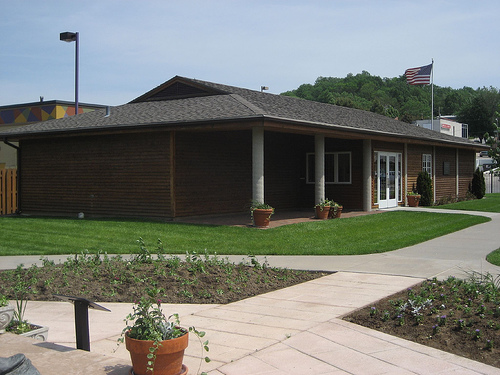Difference between revisions of "Kanesville Tabernacle"
Dennisangot (talk | contribs) |
|||
| Line 14: | Line 14: | ||
[[es: Tabernáculo de Kanesville]] | [[es: Tabernáculo de Kanesville]] | ||
| + | [[tl:Tabernakulo sa Kanesville]] | ||
Revision as of 11:53, 30 August 2011

On June 27, 1844, the president, prophet, and leader of The Church of Jesus Christ of Latter-day Saints, Joseph Smith, was killed by a mob. With the prophet's death, the leadership of the Church became the responsibility of the Quorum of the Twelve Apostles. At the time, Brigham Young was the President of the Twelve. Soon after Joseph Smith was killed, many of the Mormons were driven from their homes in Nauvoo settled in temporary homes in Iowa so that they could prepare to travel to Utah.
In December of 1847, the apostles of the Church were directed to reorganize the leadership of the Church. By this time the Twelve Apostles had been leading the Church for three and a half years. They were inspired to sustain Brigham Young as the next president and prophet. Apostles Heber C. Kimball and Willard Richards were called as first and second counselors.
The principle of common consent had been a part of the Church from its beginning, and even today Church leaders ask the consent of its members (known as sustaining) when people are called to new positions. Sustaining a new president usually mandates a "solemn assembly" where the members can offer their common consent to the calling. Because the Saints had been driven from their homes and they were now in only temporary settlements, there was no place where a large meeting could be held. Henry W. Miller, who was a bishop and one of the first of the Saints to arrive in the area, was asked by Church leaders to construct a building in Council Bluffs, Iowa, with the capacity to hold about 1,000 people. During the middle of winter, Miller and 200 men completed the log structure in just two and a half weeks. The building became known as the Kanesville Tabernacle. The building was 60 ft. by 40 ft. and was a marvel at the time, because it was one of the largest cabins ever built. The Tabernacle was dedicated on December 24, 1847.
On December 27, 1847 members of the Church crowded into the Tabernacle. Over 1,000 members were present. The newly organized First Presidency was presented to the members. Members were then asked to sustain them, or give their approval of the new First Presidency. This event is significant in the history of the Church because it was the first time that members sustained a new Prophet and First Presidency, and because it established the process that was to be followed when calling a new Prophet and First Presidency (See Choosing a Prophet).
With the arrival of spring, it was discovered that the tabernacle had been built over an underground stream and logs near the bottom of the cabin were beginning to rot. The building was used for three more years for various meetings, but it had served its purpose. When it became obvious that the logs would continue to rot, the good logs were taken off and used for other buildings.
A replica of the Kanesville Tabernacle has been constructed, and is used by the Church as a Visitors' Center. The replica was dedicated in July 1996. Inside, visitors can learn more about the Saints westward migration. It is an ideal place to house information about the Mormon Pioneers, because Kanesville was a considered the starting point and major outfitting post for the trek.